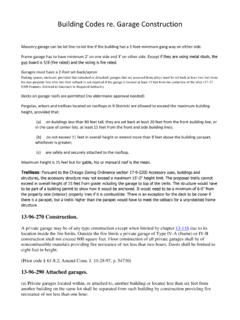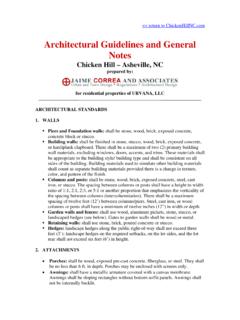Transcription of Table 3-Building Scale and Form - Long Range …
1 Page 1 of 10 building Scale and form ( Table 3) Fact Sheet & Focus Questions: BACKGROUND WHAT IS building Scale ? building Scale refers to building elements and details as they proportionally relate to each other and to humans. The following terms are used when referring to Scale and form : Size of a structure is determined by the two-dimensional measurement of the length and width combined ( , square feet). Bulk is the qualitative visual perception of the composition and shape of a structure s massing. Bulk is affected by variations in height, setbacks, and stepbacks of second stories. Mass of a structure is determined by the following elements: o The volume of the building o Variation in building shape and form o The relationship between a structure and the size of adjacent structures o The building site and its relationship to the sidewalk and street(s) and importance to human Scale RELATIONSHIP TO EXISTING GUIDELINES AND THE LAND USE DEVELOPMENT CODE The existing Board of Architectural Review (BAR) Guidelines for Summerland contains elements ( Floor Are Ratio and Height) that influence the Scale and form of a structure.
2 In addition, the Floor Area Ratio and Height have been folded into the LUDC as quantitative requirements. The topics following this discussion will reference the appropriate BAR Guidelines and/or LUDC requirements that influence that topic. Relationship to Guidelines and LUDC: o Floor Area Ratio (BAR Guidelines, pages 15-17) o Height (BAR Guidelines, pages 18-12) o Height Calculation Methodology URBAN AND RURAL AREAS The Summerland Community Plan established two subareas for the community. These two areas are the Urban Area where principally urban land uses exist and the Rural Area where land uses are rural or agricultural in nature.
3 An understanding of the character and land uses plays an important role in the development of new design guidelines. When considering building Scale and form , it is important to recognize the different characteristics of each area and the important issues of each. Page 2 of 10 FLOOR AREA RATIO (FAR) FAR is an established number which determines the amount of building area (floor area) allowed on a parcel. Generally, FAR represents a percentage of the square footage of a site. building area or floor area is based on a measurement of the structure to determine its proposed floor area. In Summerland, the building floor area must not exceed the established FAR in the Community Plan, BAR Guidelines and LUDC.
4 The Floor Area Ratio (FAR) in Summerland is unique in that it is codified and thus a hard and steadfast requirement. Other communities, such as Montecito, use the FAR as a guideline. The use of FAR as a guideline or code requirement varies from city to city and county to county. The need to control Scale through the application of FAR is understood and widely practiced. The existing Floor Area Ratios (FAR) were established based on an assessment of existing structures in Summerland and found to be compatible and consistent with the goals set forth in these guidelines. The following components determine how Floor Area is measured: Floor Area Ratio - the Floor Area Net of the structure divided by the Lot Area Net.
5 Easements or encroachments which diminish the usable area of the lot will be taken into consideration when establishing the lot area net, and this area shall be adjusted accordingly. Easements and encroachments include, but are not limited to, roads, well-sites, utility installations, portions of the property that in effect are used by other properties, etc. Floor Area Net - the total floor area of all floors of a building as measured to the surfaces of exterior walls, excluding unenclosed porches, balconies and decks. Garages and carports shall be excluded as per Limitations and Exceptions to FAR below. Interior stairs shall be counted on only one floor.
6 Single-Family Floor Area Ratio All new single family residences in any zone district except design residential shall not exceed the following standards: Lot Size Between FAR Max. Allowable 1 Up to 2,500 950 2,500 and 3,600 1,296 3,601 and 4,700 1,598 4,701 and 5,800 1,856 5,801 and 6,900 2,070 6,901 and 8,100 2,268 8,101 and 9,400 2,538 9,401 and 10,800 2,808 10,801 and 12,000 3.
7 100 1 The maximum square footage allowable is based on the minimum square footage of the next lot Range category 2 The maximum allowable square footage (sf) for lots over 12,000 sf shall be established as a base of 2,500 sf plus 5% of the lot area new with a maximum allowable size of 8,000 sf. Page 3 of 10 Note: The Maximum Allowable square footage column sets a cap on each category so that there is no overlap between the categories. Each parcel may develop to the limits set by the FAR for its parcel size except those parcels to the larger end of each category which may not develop structures larger than the Maximum Allowable square footage set for each category.
8 Example #1: If a lot is 5,998 sq. ft. (lot Range of 5,801 to 6,900 sq. ft.), the residence shall be a maximum of 1,919 (FAR of x 5,998 = 1,919 sf) Example #2: With a lot of 6,600 sq. ft. (lot Range of 5,801 to 6,900 sq. ft.), the residence shall be a maximum of 2,070 sq. ft. (although FAR of x 6,600 sq. ft. = 2,112 sq. ft.; 2,070 sq. ft. is the maximum sq. ft. allowable in that lot Range ) Duplex Floor Area Ratios The FAR for duplexes shall be Maximum duplex size shall be 3,600 sq. ft. of total living area (for both units in the duplex). Although the following requirements are regulated in the height section of the BAR Guidelines, they directly influence the Scale of a structure by reducing FAR based on the height of certain portions of a structure.
9 The following are found in the BAR Guidelines (pages 18-19). Floor Area Ratio Penalties - Plate Heights Plate heights are defined as distance between the floor and where the wall intersects with the roof or the floor joists of the story above. a. Small Lots Since it is desirable to keep the height and bulk of a building within reason, plate heights shall be factored into the FAR as follows (this applies to lots of < 1 acre): Average Plate Height FAR Adjustment up to 9' 0% 9' - 10' -10% over 10' -20% b. Large Lots On lots of 1 acre and greater, a maximum of 40% of the floor area shall be allowed to exceed a plate height of 9 ft. If more than 40% of the floor area exceeds a plate height of 9 feet, the excess will be counted as two times the floor area.
10 Floor Area Ratio Penalties - Understories Understories are defined as the portion of the structure between the exposed finished floor and the finished grade (as defined by the latest edition of the Uniform building Code) The following provisions adjust for slopes but allow for larger houses if they are well designed with minimal understories. Applicants should make every attempt to limit the height of understories, including spaces under decks. Excessive understories shall reduce the FAR as follows*: Page 4 of 10 Height of Understory FAR Adjustment Over 4 Feet - 10% Over 6 Feet - 20% 8 Feet or Over - 33% A proposed residential structure that does not qualify for a basement credit may add 5% to the FAR provided that no part of the lowest finished floor over the entire building footprint is more than 18" above grade.







